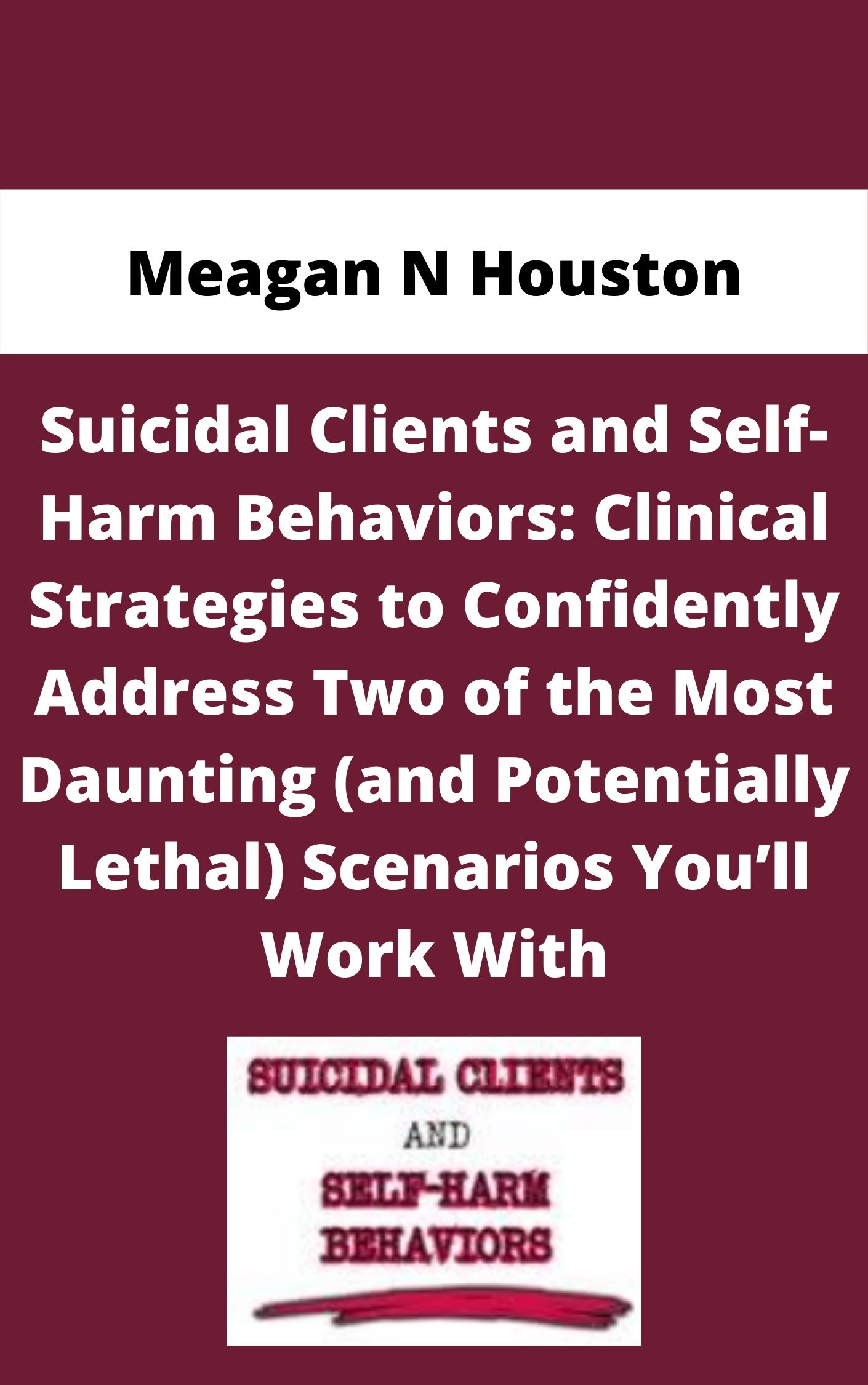Suicidal Clients and Self-Harm Behaviors: Clinical Strategies to Confidently Address Two of the Most Daunting (and Potentially Lethal) Scenarios You’ll Work With – Meagan N Houston
$199.00 Original price was: $199.00.$54.00Current price is: $54.00.
Shopping Instructions:
- DISCOUNT 30% - Paying with Crypto (BTC, ETH...)
- DISCOUNT 20% - Paying with All other payment method
- Product Delivery: After your purchase, we will send you a link to access and download the course (within 12 hours).
Suicidal Clients and Self-Harm Behaviors: Clinical Strategies to Confidently Address Two of the Most Daunting (and Potentially Lethal) Scenarios You’ll Work With – Meagan N Houston
Sale Page :
Original Price: $199
You just : $54
Description:
Suicidality is one of the scariest scenarios we work with. Your job literally becomes a life-or-death situation …one in which you hold a great deal of responsibility. Suicidal clients under extreme distress can leave you feeling overwhelmed and questioning your next move, and revelations of self-harm have you searching for answers they didn’t teach you in school.
- How do I differentiate self-injurious behavior from suicidal behavior?
- Can self-harming lead to suicidal behavior?
- How do I protect my license and livelihood when working with suicidal clients?
- What do I do when crises situations arise?
- When, and how, do I hospitalize clients?
Given the high probability of encountering a client considering suicide or engaging in self-harming behavior at some point in your career, the preparation of graduate programs is not enough. With so much as stake you need to be ready to skillfully assess and manage suicide risks and self-harming behavior!
Watch this candid recording and leave feeling fully equipped to address the intricacies that affect your clients’ choices to live or die. Beneficial to both seasoned and fledgling mental health practitioners, our experienced instructor will provide you with comprehensive approaches to effectively work with clients who present with suicidal and self-destructive behaviors.
Key Benefits of Watching:
- Risk assessment strategies that protect not only clients, but you as the clinician.
- Front line strategies derived from the evidence-based efficacy of CBT and DBT.
- Answers to difficult questions on suicide and self-harm that clinicians often struggle with.
- Effective treatment techniques, applicable across various populations and therapeutic settings.
- Tips on decision making that provide you with guideposts for determining when crisis intervention is needed in contrast to long-term treatment.
Go beyond grad school curriculum and get the practical real-world strategies and advice you need to confidently and capably treat suicidal and self-harming clients!
- Establish how a risk management strategy that accounts for both acute and chronic risk factors can help clinicians to identify clients at increased risk of suicide completion.
- Discriminate between suicide behavior and self-harm behavior and articulate how this informs the clinicians therapeutic approach.
- Explore how counter-transference can interfere in the treatment of social patients and learn how clinicians can manage emotion through awareness and self-restraint.
- Incorporate coping strategies into treatment plans for Non-Suicidal Self Injury that help clients manage triggering situations without engaging in self-harm.
- Communicate how to differentiate between morbid ideation and suicidal ideation, and establish how this information informs clinical approach.
- Articulate how social media, technology, and “tele-therapy” impact the clinician’s role in treating suicidal ideation, intent or plan.
Clients at Risk:
Co-Occurring Disorders and Special Populations
- Depressive disorders
- Anxiety disorders
- Trauma and stressor related disorders
- Substance-related and addictive disorders
- Risks in special population groups
- adolescents, veterans, LGBTQ, and the elderly
The Relationship between Suicide and Self-Destructive Behavior
- Non-Suicidal Self Injury (NSSI)
- The latest research on what drives self-harming behavior
- Is self-harm an attention-seeking behavior?
- Does self-harm lead to suicide?
- The question of intent
- Maladaptive coping mechanisms and avoidance
- Clinical screening approach for NSSI
Legally Sound Suicide Risk Assessment
- 10 essential components of a thorough risk assessment
- Chronic and acute risk factors
- Distinguishing morbid ideation vs. suicidal ideation
- Imminent/chronic suicide risk
- Self-care and consultation
- Formal assessment tools for suicide
Manage Self-Harm Behaviors and Build Functional Coping Skills in Your Clients
- Dialectical Behavior Therapy
- Teach clients techniques to increase awareness of impulsive behavior
- Communication and expressing avoided emotions
- Replacement behaviors
- Research limitations and treatment risks of psychotherapeutic approaches
Suicidal Behavior Treatment Strategies: CBT, DBT and Crisis Management Skills
- Strategies to manage countertransference
- Integrate the four key elements of crisis intervention into treatment
- Strategies from CBT and DBT
- Psychopharmacological intervention and management
- Long-term care concerns and strategies
- Tele-therapy & Social media
- APA Guidelines
- Texting – should you?
- What to do when the suicidal client contacts you by phone/social media?
- Research limitations and treatment risks of psychotherapeutic approaches
When (and How) to Hospitalize Clients
- Ethical, legal implications and case studies
- Confidentiality and minor clients
- Informed consent and state-specific laws
- Voluntary vs. involuntary commitment
- When and how to use law enforcement
Please Note: PESI is not affiliated or associated with Marsha M. Linehan, PhD, ABPP, or her organizations.
Please kindly cotact us if you need proof of item.
1 review for Suicidal Clients and Self-Harm Behaviors: Clinical Strategies to Confidently Address Two of the Most Daunting (and Potentially Lethal) Scenarios You’ll Work With – Meagan N Houston
Add a review Cancel reply
Related products
Health & Fitness
Anthony Robbins – The Ultimate Edge Program – Available Now!!!
Health & Fitness
Health & Fitness
Health & Fitness
Joey Yap – BaZi Mastery – Mapping Your Life – Available Now!!!
Health & Fitness
Health & Fitness
Health & Fitness
David Crow – Floracopeia – Aromatherapy Foundations Certification Course – Available Now !!!
Health & Fitness
Leo Gura – The Ultimate Life Purpose Course – Available Now !!!










Richard Francis –
On time item as described. | Suicidal Clients and Self-Harm Behaviors: Clinical Strategies to Confidently Address Two of the Most Daunting (and Potentially Lethal) Scenarios You’ll Work With – Meagan N Houston